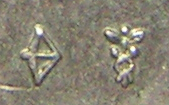| This article needs additional citations for verification. Please help improve this article by adding citations to reliable sources. Unsourced material may be challenged and removed. Find sources: "Privy mark" – news · newspapers · books · scholar · JSTOR (December 2009) (Learn how and when to remove this message) |

A privy mark was originally a small mark or differentiation in the design of a coin for the purpose of identifying the mint, moneyer, some other aspect of the coin's origin, or to prevent counterfeiting. One of the first instances of a privy mark used as a counterfeit measure was during the 17th century in a plan proposed by Sir Edward Ford to mint farthings, halfpence and three-farthings.
The main distinction between a privy mark and a mint mark lies in their purposes. Unlike a mint mark, which indicates the coin's place or source of minting, a privy mark may also indicate where a coin was minted and serves as a design and marketing element to honor a significant occasion or denote its inclusion in a specific collection. Some privy marked coins – such as the Canadian Silver Privy Marked Maple Leaf – may sell at a premium.
See also
References
- "ANS Digital Library: Mark Newby's St. Patrick coinage". numismatics.org. Archived from the original on 2018-06-23. Retrieved 2018-06-22.
This coin-related article is a stub. You can help Misplaced Pages by expanding it. |